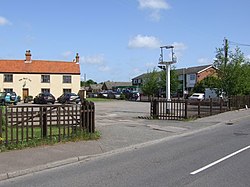Carlton Colville
| Carlton Colville | |
| Suffolk | |
|---|---|
 St Peter's Church, Carlton Colville | |
| Location | |
| Grid reference: | TM509905 |
| Location: | 52°27’14"N, 1°41’28"E |
| Data | |
| Population: | 8,505 (2011) |
| Post town: | Lowestoft |
| Postcode: | NR33 |
| Dialling code: | 01502 |
| Local Government | |
| Council: | East Suffolk |
| Parliamentary constituency: |
Waveney |
Carlton Colville is a village in Suffolk which has become a suburb of Lowestoft in the very east of the county. It is three miles south-west of the centre of the town, along the A146 Lowestoft to Beccles road.
The parish church, St Peter's, stands in the heart of the village. Its oldest surviving part was built in the 13th century.[1] Six bells hang at St Peter's, weighing up to 12-1-26 cwt.[2] The oldest bell was cast in 1608 by William Brend.[2]
Carlton Colville has boundaries with Oulton Broad, Gisleham and Pakefield. It forms the south-western edge of Lowestoft, with Mutford two miles to the south-east. It had a recorded population of 8,505 at the 2011 census.
History
Archaeological investigations have discovered evidence of settlement from the prehistoric to the mediæval periods, including three large stone axe heads dating from the neolithic or early Bronze Age discovered together in a pit.[3]
Bloodmoor Hill, located between Carlton Colville and Pakefield, was the site of settlement in the 2nd and 3rd centuries and the 7th and 8th centuries.[4] The Saxon period consisted of a relatively dense settlement as well as a cemetery which included at least one rich barrow burial.[4] Artefacts were discovered in the cemetery in the 18th century and the site was the subject of archaeological investigations between 1998 and 2006.[4][5]
In the Domesday Book, Carlton Colville is recorded as Carletuna or Karletun.[6] It had a population of 45 households and a tax value of 4½ geld[7] and was part of the estate of Earl Hugh of Chester.[7][8]
A moated site south of Carlton Colville is believed to be the site of a mediæval manor and is a scheduled monument.[9]
Local ecology
Carlton Colville has for long been a location of ecological interest. William Dutt lived in the village for many years. He annotated a coy of Flora of Suffolk by Churchill Babington and W. M. Hind, (1889) with plants found by Mrs F. Baker. Many of them were introduced species particularly found between Morse's Malthouse and a yacht building yard. This was an area where corn grown in the Levant had previously been unloaded.[10]
Carlton Colville lies to the south of the River Waveney consisting of area of marshland and reedbed. Part of the area is designated, as Sprat's Water and Marshes, as a Site of Special Scientific Interest 137 acres in size.[11] Much of this area forms part of Carlton and Oulton Marshes Nature Reserve, a site of 373 acres operated by Suffolk Wildlife Trust.[12] These areas are part of the Suffolk Broads system and are the site of rare water plants such as bladderwort and water soldier as well as dragonfly populations.[11][13]
Geography, culture and community

Carlton Colville is home to the East Anglia Transport Museum.
- Football: Carlton Colville Town FC
Outside links
References
- ↑ Knott S St Peter, Carlton Colville, Suffolk Churches. Retrieved 2009-11-28.
- ↑ 2.0 2.1 Dove's Guide, Retrieved 2012-03-21.
- ↑ Bournemouth University (2001) Archaeological Investigations Project 2001 - Field Evaluations: Suffolk. Retrieved 2009-11-28.
- ↑ 4.0 4.1 4.2 Cambridge Archaeological Unit A Roman and Saxon settlement at Bloodmoor Hill, Carlton Colville, Lowestoft Template:Webarchive. Retrieved 2009-11-28.
- ↑ English Heritage (2008) Historic Environment Enabling Programme Online - Report Detail: Bloodmoor Hill Template:Webarchive. Retrieved 2009-11-28.
- ↑ Carlton Colville, The Domesday Book Online. Retrieved 2011-04-05.
- ↑ 7.0 7.1 Colville Carlton Colville in the Domesday Book
- ↑ Domesday Book: folio 302r, National Archives.
- ↑ National Heritage List 1018331: Moated site south west of Bell Farm (Scheduled ancient monument entry)
- ↑ Simpson, F. W. (20 December 2016). New plants in Suffolk recorded by W. A. Dutt (1870-1939). https://issuu.com/suffolknaturalistssociety/docs/tsns8_3_n/1. Retrieved 14 November 2022.
- ↑ 11.0 11.1 SSSI listing and designation for Sprat's water and marshes
- ↑ Carlton and Oulton Marshes, Suffolk Wildlife Trust. Retrieved 2013-05-29.
- ↑ BBC breathing spaces events, BBC Suffolk, 2008. Retrieved 2011-04-21.